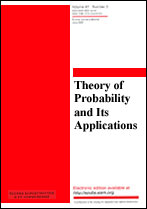|
This article is cited in 2 scientific papers (total in 2 papers)
Explicit expressions of the Hua–Pickrell semigroup
J. Aristaa, N. Demnib
a Centro de Modelamiento Matemático, Universidad de Chile
b Aix-Marseille Université
Abstract:
In this paper, we study the one-dimensional Hua–Pickrell diffusion. We start by
revisiting the stationary case considered by E. Wong for which we supply omitted
details and write down a unified expression of its semigroup density through the
associated Legendre function in the cut. Next, we focus on the general (not
necessarily stationary) case for which we prove an intertwining relation between
Hua–Pickrell diffusions corresponding to different sets of parameters. Using
the Cauchy beta integral on the one hand and Girsanov's theorem on the other
hand, we discuss the connection between the stationary and general cases.
Afterwards, we prove our main result providing novel integral representations of
the Hua–Pickrell semigroup density, answering a question raised by Alili,
Matsumoto, and Shiraishi [Séminaire de Probabilités XXXV,
Lecture Notes in Math. 1755, Springer,
2001, pp. 396–415]. To this end, we appeal to the semigroup density of the
Maass Laplacian and extend it to purely imaginary values of the magnetic field.
In the last section, we use the Karlin–McGregor formula to derive an expression
of the semigroup density of the multidimensional Hua–Pickrell particle system
introduced by T. Assiotis.
Keywords:
Hua–Pickrell diffusion, Routh–Romanovski polynomials, associated Legendre function, exponential functionals, Bougerol's identity.
Received: 01.09.2020
Revised: 27.01.2021
Accepted: 18.02.2021
Citation:
J. Arista, N. Demni, “Explicit expressions of the Hua–Pickrell semigroup”, Teor. Veroyatnost. i Primenen., 67:2 (2022), 264–288; Theory Probab. Appl., 67:2 (2022), 208–228
Linking options:
https://www.mathnet.ru/eng/tvp5432https://doi.org/10.4213/tvp5432 https://www.mathnet.ru/eng/tvp/v67/i2/p264
|


| Statistics & downloads: |
| Abstract page: | 192 | | Full-text PDF : | 26 | | References: | 27 | | First page: | 6 |
|




 Contact us:
Contact us: Terms of Use
Terms of Use
 Registration to the website
Registration to the website Logotypes
Logotypes








 Citation in format
Citation in format 
